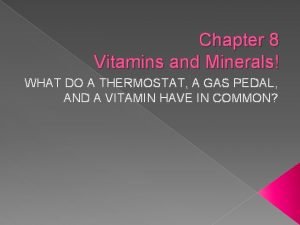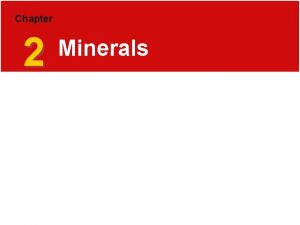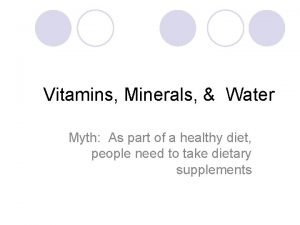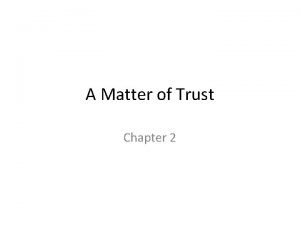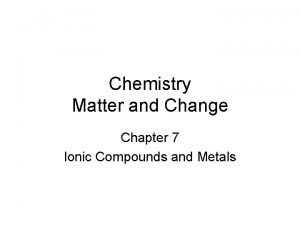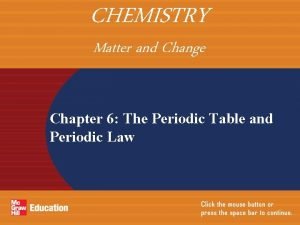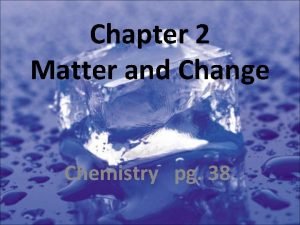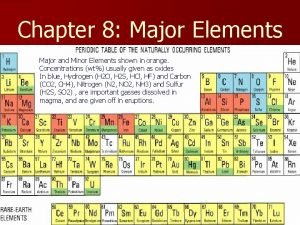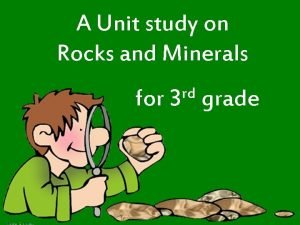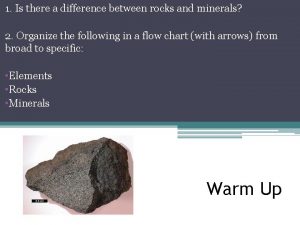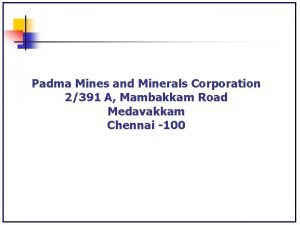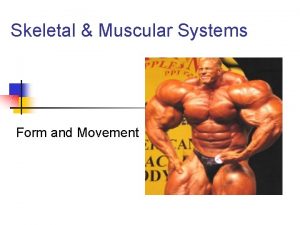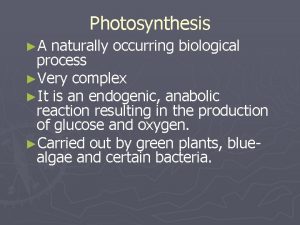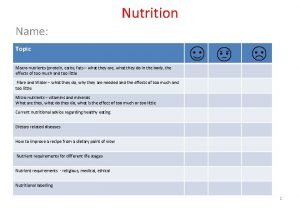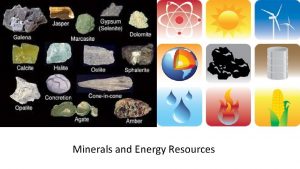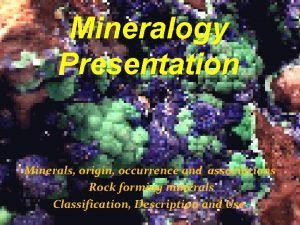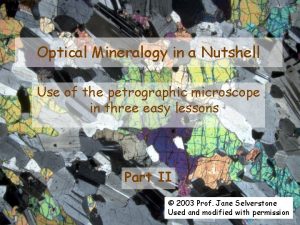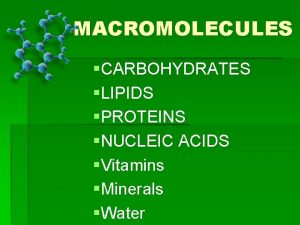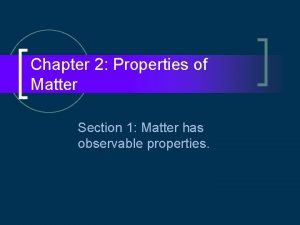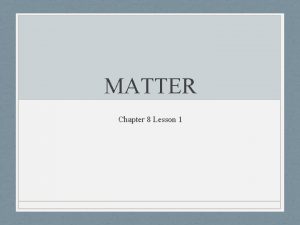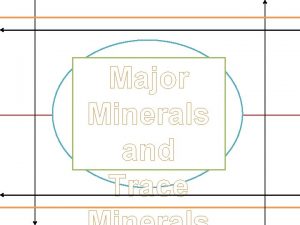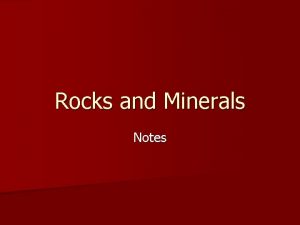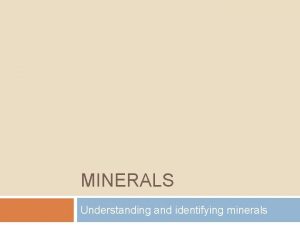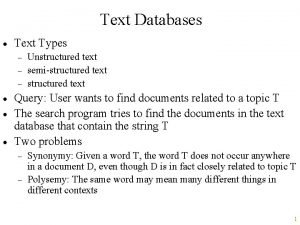Matter and Minerals Chapter 2 in text Minerals




















































- Slides: 52

Matter and Minerals (Chapter 2 in text)

Minerals: Building blocks of rock (광물: 암석을 만드는 브럭< 덩어리>) Definition of a mineral: (광물의 정의) • Naturally occurring(자연에서 산출) • Inorganic solid(무기질 고체) • Ordered internal molecular structure(질서있 는 내부 분자구조) • Definite chemical composition(일정한 화학조성) Definition of a rock: ( 암석의 정의) • A solid aggregate or mass of minerals • (고상의 집합체 혹은 광물들의 집단)

Quartz - A Common Mineral

Periodic Table of the Elements

Composition of Elements (원소의 조성) Atomic structure( 원자구조) • Central region called the nucleus(중심은 핵) – Consists of protons (positive charges) and neutrons (neutral charges)( 양전하를 갖는 양성자와 중성 을 갖는 중성자로 구성) • Electrons(전자) – Negatively charged particles that surround the nucleus(핵 주위를 도는 음전하의 입자) – Located in discrete energy levels called shells – (껍질로 불리우는 불연속 에너지 준위)

Idealized structure of an atom

Composition of minerals (광물의 조성) Chemical bonding( 화학결합) • Formation of a compound by combining two or more elements(둘 혹은 그이상의 원소가 결합하여 혼합 물을 만듬) Ionic bonding( 이온결합) • Atoms gain or lose outermost (valence) electrons to form ions(최외각 전자를 얻거나 잃어서 이온화) • Ionic compounds consist of an orderly arrangement of oppositely charged ions • (이온 결합물은 반대되는 전하의 질서적인 배열로 구성)

Halite (Na. Cl)- An Example of Ionic Bonding ( 암염 의 예)

Composition of minerals Covalent bonding(공유결합) • Atoms share electrons to achieve electrical neutrality( 원자들이 전기적으로 중성을 띠기 위하여 전자를 공유) • Covalent compounds are generally stronger than ionic bonds(공유결합물은 이온결합물보다 이반적으로 강함) • Both ionic and covalent bonds typically occur in the same compound (bonds are seldom 100% ionic or covalent in character)(전형적으로 이온결합, 공유결합 모두 가 같은 결합물 내에서 존재< 결합들은 드물게 100% 이온결합 혹은 공유결합을 갖는다>)

Covalent bonding – sharing of valence electrons

Composition of minerals Other types of bonding(다른형의 결합) • Metallic bonding(금속결합) – Valence electrons are free to migrate among atoms(원자가전자는 원자들 내에서 자유롭게 이동) – Weaker and less common than ionic or covalent bonds( 이온결합 혹은 공유결합보다 약하고 훨씬 덜 보편 적임)

Composition of minerals Isotopes and radioactive decay(동위원소와 방사성붕괴) • Mass number is the sum of neutrons plus protons in an atom(질량수는 원자의 양성자와 중성자를 더한수 ) • An isotope is an atom that exhibits variation in its mass number(동위원소는 그 질량값이 다양한 값을 보이는 원자) • Some isotopes have unstable nuclei that emit particles and energy in a process known as radioactive decay( 어떤 동위원소는 방사성붕 괴로 알려진 과정에서 입자와 에너지를 방출하여 불안정한 핵을 갖는다)

Structure of minerals Minerals consist of an orderly array of atoms chemically bonded to form a particular crystalline structure(광물들은 특정한 결 정질 구조를 형성하기 위하여 화학적으로 결합된 원자들의 질서적으로 배열로 구성) For ionic compounds, the internal atomic arrangement is primarily determined by the size of ions involved(이온결합물이 되기 위하여는, 내부 원자 배열이 근본적으로 이온들이 가진 크기에 의해 결정되어진다 )

Halite (Na. Cl) (Packing Related to Cation and Anion Size)

Structure of minerals Polymorphs(동질다상) • Two or more minerals with the same chemical composition but different crystalline structures(같은 화학조성을 갖는 둘 혹은 그 이상의 광물들 이 다른 결정구조를 갖는것) • Diamond and graphite are good examples of polymorphs(다이아몬드와 흑연) – The transformation of one polymorph to another is called a phase change(상 변이) – Example: Peanut Butter in a High Pressure Cell Makes Diamond

Diamond and graphite – polymorphs of carbon

Physical properties of minerals (광물의 물리적 성질) Crystal Form(결정형, 모양) • External expression of the orderly internal arrangement of atoms • (원자의 질서정연한 내부 배열이 외부에 표시된것) • Crystal growth is often interrupted because of competition for space and rapid loss of heat 정 성장은 빠른 열의 감소와 공간에 대한 경합 때문에 자주 중단된다) • Note this isn’t cleavage!(주의 이것이 벽개는 아니다) (결

The mineral garnet often exhibits good crystal form

Physical properties of minerals Luster(광택) • Appearance of a mineral in reflected light( 반사되는 빛에 대한 광물의 현상) • Two basic categories(두가지 기본 범주) – Metallic( 금속광택) – Nonmetallic( 비금속광택) • Other terms are used to further describe luster such as vitreous (oily), silky, or earthy (like dirt)(기타의 다른 용어로 유리질<유상>, 견사질, 혹은 토질<진흙질, > 등으로 표현되어 사용)

Galena is a lead sulfide that displays metallic luster (방연광으 로 금속광택을 보여주는 황화연)

Physical properties of minerals Color • Generally an unreliable diagnostic property to use for mineral identification ( 일반적으로 광물을 구별하기 위해 사용되는 신뢰성 없는 진단 성질) • Often highly variable for a given mineral due to slight changes in mineral chemistry • (광물화학적으로 적은 변화에 기인하여 소정의 광물에 종종 큰 다양성을 갖는다) • Exotic colorations of some minerals produce gemstones( 어떤 광물의 색다른 채색은 보석을 산출한다) • But we use it anyway : )

Quartz (Si. O 2) exhibits a variety of colors

Physical properties of minerals Streak (조흔) • Color of a mineral in its powdered form • (광물 분말의 색) • Helpful in distinguishing different forms of the same mineral(같은 광물의 다른 형태를 특징짓는데 유용함) Hardness ( 굳기) • Resistance of a mineral to abrasion or scratching(마모나 긁킴에 대한 광물의 저항) • All minerals are compared to a standard scale called the Mohs scale of hardness 모든 광물은 모스 경도라 불리는 기준 척도와 비교된다) (


Physical properties of minerals Cleavage (벽개) • Tendency to break along planes of weak bonding(약한 결합면을 따라 쪼개지는 경향) • Produces flat, shiny surfaces(평탄면, 빛나는 표면을 갖는다) • Described by resulting geometric shape (기하 학적 모양에 의해 표시됨) – Number of planes( 면의 수) – Angles between adjacent planes(인접한 면사이의 각도)

Three examples of perfect cleavage – fluorite , halite , and calcite (형석) (암염) (방해석)

Micas have perfect cleavage ( 운모류의 완벽한 벽개 의모양) muscovite

Physical properties of minerals Fracture ( 단구, 열극) • Absence of cleavage when a mineral is broken( 광물이 개질때 벽개의 부재) Specific Gravity ( 비중) • Ratio of the weight of a mineral to the weight of an equal volume of water ( 같은 부피의 물에 무게에 대한 광물 무게 의 비율) • Average value is approximately 2. 7( 평균값은 2. 7) • Simply hefting a mineral works too. ( 단순 히 무게를 다는 일)

Conchoidal fracture (패각상 단구)

Physical properties of minerals Other properties • Magnetism(자기성) • Reaction to hydrochloric acid(염산에 대한 반응) • Malleability(전성) • Double refraction( 복굴절 ) • Taste( 맛) • Smell( 냄새) • Elasticity( 탄성)

Classification of Minerals (광물분류) Nearly 4000 minerals have been identified on Earth (most of which we don’t really worry about). (거의 4천점이 분류되어있다) Rock-forming minerals(조암 광물) • Common minerals that make up most of the rocks of Earth’s crust (지각구 성 암석의 대부분을 만드는 일반적 광물) • Only a few dozen members( 고작 12종류 정도) • Composed mainly of the 8 elements that make up 98% of the continental crust(대륙지 각의 98%가 주로 8대 원소로 구성되어있음과 같이)


Classification of Minerals Silicates(규산염 광물) • Most important mineral group – Comprise most of the rock-forming minerals( 조암광물의 대부분을 구성하고있음) – Very abundant due to large amounts of silicon and oxygen in Earth’s crust(지각내에 규소와 산소의 많은 양에 기인하여 매우 많이 분포함) • Basic building block is the silicon-oxygen tetrahedron molecule(기본구조는 규소-산소 사면체 분자구조) – Four oxygen ions surrounding a much smaller silicon ion(아주 작은 규소이온을 4개의 산소 이온으로 둘러 쌓인구조)

Silica Tetrahedra (1 Si, 4 O’s)

Classification of Minerals Silicate structures(규산염구조) • Single tetrahedra are linked together to form various structures including(하나의 사면체 는 아래에 다양한 형 으로 연결되어진다. ) – Isolated tetrahedra(독립사면체) – Ring structures(환형 구조) – Single and double chain structures(단쇄, 복쇄구조) – Sheet or layered structures(판상 혹은 층상구조) – Complex 3 -dimensional structures( 혼합 3차원 즉 망 상 구조)


Classification of Minerals Common Silicate minerals(일반 규산염광물) • Olivine(감람석) – High temperature Fe-Mg silicate (typical mantle mineral - formed 100’s km in Earth) ( 고온의 철-마그네슘 규산염<대표적 맨틀광물-지구 내 100 키로 정도에서형성 ) – Individual tetrahedra linked together by iron and magnesium ions(각 사면체는 철과 마그네슘 이온에의해 연결 되어 있음) – Forms small, rounded crystals with no cleavage( 작고 원형으로 된 벽개면이 없는 결정)

Classification of Minerals Common Silicate minerals • Pyroxene Group(휘석 그룹) – Single chain structures involving iron and magnesium(철과 마그네슘을 함유하는 단쇄구조) – Two distinctive cleavages at nearly 90 degrees – (거의 90도를 갖는 두개의 구별되는 벽개면) – Augite is the most common mineral in the pyroxene group( 단사 휘석은 휘석그룹에서 가장 보편적인 광물)

Classification of Minerals Common Silicate minerals • Amphibole Group(각섬석그룹) – Double chain structures involving a variety of ions(다양한 이온을 함유하는 복쇄구조) – Two perfect cleavages exhibiting angles of 124 and 56 degrees( 124도와 56도의 두개의 완벽한 벽개면을 보인다) – Hornblende is the most common mineral in the amphibole group(각섬석은 각섬석 그룹애서 가장 일반적 인 광물이다. )

Hornblende Crystal Habit and Atomic Structure

Classification of Minerals Common Silicate minerals • Mica Group(운모 그룹) – Sheet structures that result in one direction of perfect cleavage(한뱡향의 완벽한 벽개 결과로 판상 구조를 ) – Biotite is the common dark colored mica mineral( 흑운모는 일반적으로 검은색 운모 광물이다) – Muscovite is the common light colored mica mineral ( 백운모는 일반적으로 밝은색 운모 광물이다)

Muscovite(백운모)

Classification of Minerals Common Silicate minerals • Feldspar Group(장석그룹) – Most common mineral group( 가장 보편적인 광물그룹) – 3 -dimensional framework of tetrahedra exhibit two directions of perfect cleavage at 90 degrees(사면체의 3차원 구조가 90도에서 완벽한 벽개면의 두 뱡향 을 보여준다) – Orthoclase (potassium feldspar) and Plagioclase (sodium and calcium feldspar) are the two most common members(정장석<칼륨장석>과 사장석<나트륨과칼슘장석>은 두개의 가장 보편적인 종류이다)

Potassium feldspar

Plagioclase feldspar

Classification of Minerals Common Silicate minerals • Clay minerals(점토광물) – Clay is a general term used to describe a variety of complex minerals(점토는 다양한 혼합광물로 표 현하는데 사용되는 일반적인 항이다) – Clay minerals all have a sheet or layered structure(점토광물들은 모두 판상 혹은 층상구조를 갖는다) – Most originate as products of chemical weathering(대부분 화학적 풍화작용의 산물로 그 기원이다)

Clay Minerals (at high magnification)

Classification of Minerals Important nonsilicate minerals(중요한 비규산염 광물) • Several major groups exist including (여러 개의 주요 그룹이 여기에 포함된다) – Oxides(산화광물) – Sulfides(황화광물) – Sulfates(황산염광물) – Native Elements(원소광물) – Carbonates(탄산염광물) – Halides(할로겐염광물) – Phosphates(인산염광물)

Classification of Minerals Important nonsilicate minerals • Carbonates(탄산염) – Primary constituents in limestone and dolostone(석회암과 돌로스톤 에 기본적인 성분) – Calcite (calcium carbonate) and Dolomite (calcium-magnesium carbonate) are the two most important carbonate minerals (방해석 <탄산칼슘>과 백운석<탄산칼슘-마그네슘>은 탄산염광물중 가장 중요한 광 물이다)

Classification of Minerals Important nonsilicate minerals • Many nonsilicate minerals have economic value(많은 비규산염 광물들이 경제적 가치를 갖는 것이 많다) • Examples – Hematite (oxide mined for iron ore)(적철광) – Halite (halide mined for salt)(암염) – Sphalerite (sulfide mined for zinc ore)(섬아연광) – Native Copper (native element mined for copper)(자연동)

Native Copper (End Minerals)

End Minerals
 What is an example of a text-to-media connection?
What is an example of a text-to-media connection? Chapter 2 section 1 classifying matter answers
Chapter 2 section 1 classifying matter answers Koosha golmohammadi
Koosha golmohammadi Median and lateral apertures
Median and lateral apertures Gray matter and white matter
Gray matter and white matter What is gray matter
What is gray matter Classification of matter section 1 composition of matter
Classification of matter section 1 composition of matter Classification of matter section 1 composition of matter
Classification of matter section 1 composition of matter Section 1 composition of matter
Section 1 composition of matter Flow of energy vs flow of matter
Flow of energy vs flow of matter Chapter 8 vitamins and minerals
Chapter 8 vitamins and minerals Chapter 2 minerals
Chapter 2 minerals Minerals and their functions sources and deficiency chart
Minerals and their functions sources and deficiency chart Chemistry matter and change chapter 7
Chemistry matter and change chapter 7 Chapter 10 the mole study guide
Chapter 10 the mole study guide Chapter 1 review matter and change
Chapter 1 review matter and change A matter of trust book summary
A matter of trust book summary 1s 22 s22 p63 s23 p64 s2
1s 22 s22 p63 s23 p64 s2 Chemistry matter and change chapter 6
Chemistry matter and change chapter 6 Chemistry matter and change chapter 10 the mole answer key
Chemistry matter and change chapter 10 the mole answer key Chemistry matter and change chapter 2 answer key
Chemistry matter and change chapter 2 answer key Circle the solute and underline the solvent
Circle the solute and underline the solvent Chapter 11 - states of matter: liquids and solids
Chapter 11 - states of matter: liquids and solids Source text
Source text Text analytics and text mining
Text analytics and text mining Text analytics and text mining
Text analytics and text mining Example of linear text
Example of linear text Song about igneous rocks
Song about igneous rocks Granite and basalt difference
Granite and basalt difference What are the elements of major and minor minerals
What are the elements of major and minor minerals Difference between rocks and minerals
Difference between rocks and minerals Concept map about rocks
Concept map about rocks Suzanna socked me sunday poem
Suzanna socked me sunday poem Absorbs water and minerals
Absorbs water and minerals What kind of rock is this
What kind of rock is this Padma mines and minerals corporation
Padma mines and minerals corporation Stores minerals and anchors muscles
Stores minerals and anchors muscles Cumbria minerals and waste local plan
Cumbria minerals and waste local plan Resources that can be replaced
Resources that can be replaced Minerals and fuels
Minerals and fuels Deficiency chart of macronutrients
Deficiency chart of macronutrients Minerals and fuels
Minerals and fuels Prepare chart for vitamins and minerals
Prepare chart for vitamins and minerals Vitamin flowchart
Vitamin flowchart Rock type
Rock type Isotropic minerals
Isotropic minerals Site:slidetodoc.com
Site:slidetodoc.com Chapter 12 states of matter study guide
Chapter 12 states of matter study guide Chapter 10 review states of matter section 4
Chapter 10 review states of matter section 4 Composition of matter chapter 9
Composition of matter chapter 9 Chapter 2 properties of matter
Chapter 2 properties of matter Chapter 8 lesson 1
Chapter 8 lesson 1 Non examples of homogeneous mixture
Non examples of homogeneous mixture










